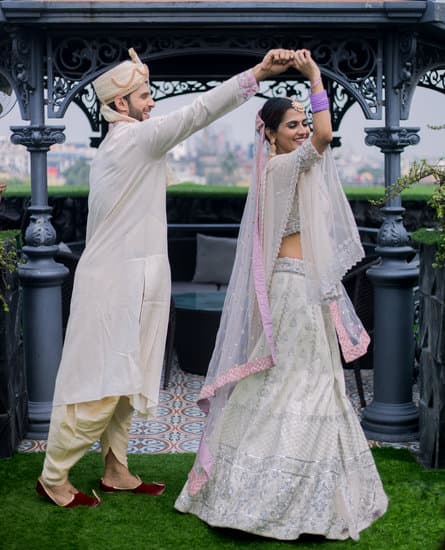A traditional Indian wedding is a vibrant and elaborate affair that is steeped in rich cultural traditions and customs. From pre-wedding rituals to post-wedding ceremonies, each aspect of the celebration holds deep significance for the couple and their families.
One of the most common questions that arise when discussing traditional Indian weddings is, “How many days is a traditional Indian wedding?” In this blog post, we will delve into the various rituals and ceremonies that make up a traditional Indian wedding, as well as explore the duration of these elaborate celebrations.
Before we can understand the duration of a traditional Indian wedding, it’s essential to first familiarize ourselves with the pre-wedding rituals, wedding day customs, and post-wedding ceremonies that make up these joyous occasions. Each aspect of the wedding holds its own unique symbolism and cultural importance, contributing to the overall significance of the celebration.
Additionally, regional variances play a significant role in shaping the length and customs of a traditional Indian wedding based on the couple’s cultural background and regional influences.
Throughout this blog post, we will provide an in-depth look at all aspects of traditional Indian weddings, including how long they typically last and why they are celebrated over multiple days. We will also explore modern adaptations and regional variances that may impact the duration and customs of these beautiful unions. By the end of this discussion, you will have gained valuable insight into the enduring cultural significance of traditional Indian weddings.
Pre-Wedding Rituals
A traditional Indian wedding is not just a one-day affair, but rather a series of events and ceremonies that can span several days. The pre-wedding rituals play an important role in preparing the bride and groom for their union and are filled with meaning and symbolism. These ceremonies are a time for family and friends to come together to celebrate the upcoming marriage.
The pre-wedding festivities usually begin with the Haldi ceremony, also known as the pithi ceremony, where turmeric paste is applied to the bride and groom’s skin. This signifies the cleansing of the body and soul before their wedding day.
Following this is the Mehendi ceremony, where intricate henna designs are applied to the bride’s hands and feet as a symbol of beauty, spiritual awakening, and offering joy. Both of these ceremonies are accompanied by singing, dancing, and joyful celebrations.
In addition to the Haldi ceremony and Mehendi ceremony, there may be other pre-wedding rituals such as the Ganesh Puja or engagement ceremony that are specific to different regions or communities within India. Each of these ceremonies holds its own significance in preparing the couple for their new life together, surrounded by love and support from their families. These pre-wedding rituals are an essential part of traditional Indian weddings, emphasizing the importance of family bonds and cultural traditions.
Wedding Day
A traditional Indian wedding is a rich tapestry of customs, rituals, and celebrations that span over several days. The actual wedding day itself is a culmination of all the preparations and ceremonies that have taken place in the lead up to this momentous occasion. From the exchange of vows to the traditional wedding attire, the wedding day is filled with significance and symbolism.
On the morning of the wedding day, both the bride and groom partake in separate pre-wedding rituals. These rituals can vary based on regional traditions but often involve prayers, blessings from family members, and intricate henna designs applied to the bride’s hands and feet. The Mehendi ceremony is an essential part of the pre-wedding festivities, where intricate patterns are drawn on the bride’s skin as a symbol of love, joy, and spiritual awakening.
As the day progresses, family and friends gather for the main event – the marriage ceremony. The exchange of vows takes place amidst elaborate decorations, colorful flowers, and traditional music. The couple may circle around a holy fire or take seven steps together to symbolize their commitment and union. The bride adorns herself in a stunning red or gold saree or lehenga while the groom is dressed in ornate sherwani or kurta – each outfit representing tradition and cultural heritage.
Following these sacred customs come more lighthearted traditions such as stealing shoes and playful banter between families. Despite being steeped in ancient customs, there’s always room for joyful celebration during a traditional Indian wedding.
- Pre-Wedding Rituals: Exploring various ceremonies before wedding
- Mehendi ceremony: Applying intricate henna designs
- Main Event: Marriage ceremony with exchange of vows
- Traditional Attire: Description of bridal and groom attire
- Post-Ceremony Customs: Light-hearted post-wedding traditions
Post-Wedding Rituals
A traditional Indian wedding is a grand affair that involves various rituals and ceremonies that last for several days. These celebrations are not only a significant event for the bride and groom but also an occasion for their families to come together and partake in age-old customs.
Post-wedding rituals are an essential part of traditional Indian weddings, signifying the beginning of the couple’s life together as well as bidding farewell to the bride as she starts her new journey with the groom’s family. One of the key post-wedding rituals is the reception, which is usually a lavish event where guests are invited to celebrate the union of the newlyweds.
It is marked by feasting, music, and dancing, creating a joyful atmosphere for everyone involved.
Another important post-wedding ritual in Indian weddings is the Bidai ceremony, which involves emotional moments as the bride says goodbye to her family and leaves for her new home with her husband. This ritual holds immense significance and symbolizes the end of one chapter in her life and the beginning of a new one with her spouse’s family. These post-wedding rituals add depth and meaning to traditional Indian weddings, reflecting both joyous celebrations and sentimental farewells.
| Post-Wedding Rituals | Duration |
|---|---|
| Reception | 1 day |
| Bidai Ceremony | 1 day |
Duration of a Traditional Indian Wedding
A traditional Indian wedding is a vibrant and elaborate affair that extends over several days, allowing for the celebration of various customs and rituals. The duration of a traditional Indian wedding can vary, typically lasting anywhere from three to seven days, depending on regional customs and family traditions. This extended period allows for the inclusion of numerous pre-wedding, wedding day, and post-wedding rituals, each holding significant cultural and religious importance.
Pre-Wedding Rituals
The pre-wedding rituals in a traditional Indian wedding can often span over several days leading up to the main event. These rituals may include the Haldi ceremony, where turmeric paste is applied to the bride and groom to cleanse and purify them before their wedding day.
Additionally, the Mehendi ceremony is held, during which intricate henna designs are applied to the bride’s hands and feet as a symbol of beauty, joy, and spiritual awakening. These pre-wedding celebrations build anticipation for the main event while serving as an opportunity for families and friends to come together in preparation for the union.
Wedding Day
The actual wedding day in a traditional Indian wedding is filled with numerous customs and ceremonies that can last throughout the day. From the exchange of vows amidst sacred rituals such as Agni Puja or Mangal Pheras to donning exquisite traditional attire like sarees or lehengas, this day is marked by elaborate traditions that hold deep symbolic significance within Indian culture.
Post-Wedding Rituals
Following the wedding day itself comes a series of post-wedding rituals such as the reception, which serves as an official introduction of newlyweds to their extended families and friends. The bidai ceremony marks the conclusion of these festivities as it symbolizes the bride’s departure from her parental home to start her new life with her husband. These post-wedding ceremonies are designed to bring closure to the extravagant celebrations while also marking new beginnings for the couple.
Regional Variances
In a diverse and culturally rich country like India, it should come as no surprise that the length and customs of a traditional wedding can vary significantly based on the region and the cultural background of the couple. Each region in India has its own unique traditions, rituals, and customs that are reflected in the length and festivities of a traditional Indian wedding.
North India
In North India, traditional weddings are known for their grandeur and elaborate celebrations that can last anywhere from three to seven days. These weddings often include pre-wedding rituals such as the Sagan ceremony, Chunni Chadana, and engagement ceremony.
The actual wedding day is filled with customs like the Baraat procession, Jaimala (exchange of garlands), and the sacred pheras around the holy fire. Post-wedding rituals can also extend for several days, including receptions and other ceremonies specific to each family’s traditions.
South India
On the other hand, South Indian weddings typically last for one to five days depending on the community and their specific customs. These weddings may include pre-wedding rituals such as Nischayam (formal engagement) and Mehendi ceremony.
On the wedding day itself, there are rituals like Kanyadaanam (giving away the bride), Mangalya Dharane (tying of thali), Saptapadi (seven steps around the fire), and more. Post-wedding events such as Grihapravesham (newlywed’s first entry into their home) also add to the duration of these celebrations.
West & East India
The length of traditional Indian weddings in West and East India also varies extensively based on diverse cultural influences. For example, in Bengali weddings in East India, rituals like Aashirwad (blessings from elder family members) and Sindoor Daan (applying vermilion by groom) contribute to extending the festivities for multiple days. In contrast, Maharashtrian weddings in West India may have a relatively shorter duration but still involve intricate customs like Antarpat ritual during the actual wedding ceremony.
Modern Adaptations
Modern Indian weddings have undergone significant changes in terms of duration and customs compared to traditional weddings. One of the most notable differences is the length of the celebration. While traditional Indian weddings are known for their extensive duration, modern adaptations often involve shorter celebrations that typically last for two to three days as opposed to the traditional seven-day affair.
The modernization of Indian weddings can be attributed to various factors such as changing lifestyles, economic considerations, and the desire for more personalized and intimate ceremonies. Couples are opting for shorter wedding celebrations to accommodate busy work schedules and to minimize the financial burden associated with extended festivities.
Another prominent aspect of modern Indian weddings is the incorporation of contemporary elements alongside traditional customs. For instance, couples may choose to hold their wedding at luxurious venues and resorts rather than ancestral homes or community halls. Additionally, modern weddings often feature innovative themes, extravagant decor, and fusion cuisines, reflecting a blend of traditional and global influences.
| Aspect | Details |
|---|---|
| Duration | Two to three days |
| Venue | Luxurious venues and resorts |
| Customs | Incorporation of contemporary elements alongside traditional customs |
Conclusion
In conclusion, traditional Indian weddings are multi-day celebrations filled with meaningful rituals and customs that have been passed down through generations. From the pre-wedding Haldi and Mehendi ceremonies to the post-wedding reception and bidai ceremony, each event holds great significance in the union of two individuals.
The wedding day itself is a vibrant display of colors, traditions, and love as the couple exchanges vows and participates in time-honored customs. The duration of a traditional Indian wedding typically spans several days, highlighting the importance of family, community, and cultural heritage.
One of the most fascinating aspects of a traditional Indian wedding is its duration. These celebrations can last anywhere from three to seven days or even longer, depending on regional variances and cultural backgrounds. This extended timeframe allows for the inclusion of numerous pre-wedding and post-wedding rituals that hold deep symbolic meaning for the couple and their families. It also provides ample opportunity for loved ones to come together, forge connections, and create lasting memories.
Overall, traditional Indian weddings encapsulate the rich cultural significance of India’s diverse communities. They serve as a beautiful reflection of age-old traditions while also embracing modern adaptations. As couples honor their heritage through these elaborate ceremonies, they also symbolize the fusion of old and new, creating a unique blend that speaks to the timeless beauty of love and tradition in Indian culture.
Frequently Asked Questions
How Long Does a Traditional Wedding Take?
A traditional wedding typically lasts for several hours, but the entire celebration may span over a whole day or even multiple days, depending on cultural customs and rituals. The ceremony itself can vary in length, from relatively quick to several hours long, and is often followed by a reception that includes dinner and dancing.
How Many Days Is a Wedding?
The duration of a wedding can vary widely based on the specific customs and traditions of the couple getting married.
While some weddings may only last for a single day with a ceremony and reception, others may extend over a weekend or consist of multiple events spread out over several days, such as pre-wedding ceremonies, the actual wedding day, and post-wedding gatherings.
How Many Days Is a South Indian Wedding?
A South Indian wedding typically extends beyond just one day and can last up to three or four days. This longer duration allows for various traditional ceremonies to take place before the main wedding day, such as mehendi (henna), haldi (turmeric), and more. The culmination is often a grand wedding ceremony followed by elaborate festivities with food, music, and dance.

I have been involved in marriages for over 20 years helping couples and singles understand more about them.


![How Many Days for RSVP Wedding RSVP by [date] for the wedding: How many days do I have to RSVP for the wedding](https://www.marriagespirit.com/wp-content/uploads/2023/11/wedding-955-150x150.jpg)


